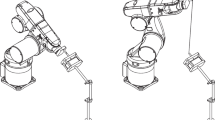Abstract
It is well known that identification of geometric parameters can significantly enhance the accuracy of robot manipulators. A number of different approaches to manipulator calibration have been demonstrated in the recent literature. A part of the calibration process that is common to all of the proposed techniques is the collection of a dataset that relates the measured position and possibly the orientation of the end-effector to the joint displacements for a number of poses. This data-acquisition step is usually the most tedious part of the calibration process. Accurate location of points on the end-effector can be quite time consuming to accomplish manually and the equipment for automated data acquisition is expensive.
The purpose of this work, therefore, is to demonstrate a simplified approach to acquiring the data necessary for manipulator calibration. In the proposed approach, the only equipment used for data measurements is a flat plate and a test block mounted on the end of the robot arm. To demonstrate the method, a model and an identification algorithm for a PUMA 560 manipulator are developed. The data-collection process is described and the procedure is validated through a computer simulation. Finally, an experiment is conducted whereby data is collected for a PUMA manipulator and used to identify the kinematic parameters. The resulting manipulator model leads to a significant improvement in accuracy.
Similar content being viewed by others
References
Z. Roth, B. W. Mooring and B. Ravani, “An overview of robot calibration”,IEEE Journal of Robotics and Automation,RA-3(5), pp. 377–385, October 1987.
J. M. Hollerbach, “A survey of kinematic calibration”, inThe Robotics Review 1988, MIT Press, pp. 207–242, 1988.
D. E. Whitney, C. A. Lozinski and J. M. Rourke, “Industrial robot forward calibration method and results”,Journal of Dynamic Systems, Measurement, and Control,108(1), pp. 1–8, March 1986.
R. P. Judd and A. B. Knasinksi, “A technique to calibrate industrial robots with experimental verification”,Proceedings of 1987 IEEE International Conference on Robotics and Automation, Raleigh, N.C., pp. 351–357, April 1987.
K. Lau, R. J. Hocken and W. C. Haight, “Automatic laser tracking interferometer system for robot metrology”,Precision Engineering,8(1), January 1986.
W. K. Veitschegger and C.-H. Wu, “A method for calibrating and compensating robot kinematic errors”,Proceedings of 1987 IEEE International Conference on Robotics and Automation, Raleigh, N.C., pp. 39–44, April 1987.
B. W. Mooring and S. S. Padavala, “The effect of model complexity on robot accuracy”,Proceedings of 1989 IEEE Conference on Robotics and Automation. Scottsdale, Ariz., pp. 593–598, May 1989.
H. W. Stone,Kinematic Modeling, Identification, and Control of Robotic Manipulators, Kluwer Academic Publishers, 1987.
H. W. Stone and A. C. Sanderson, “A prototype arm signature identification system”,Proceedings of 1987 IEEE International Conference on Robotics and Automation, Raleigh, N.C., pp. 175–182, April 1987.
H. W. Stone, A. C. Sanderson and C. P. Neuman, “Arm signature identification”,Proceedings of 1986 IEEE International Conference on Robotics and Automation, San Francisco, California, pp. 41–48, April 1986.
P. G. Ranky and M. Wodzinski, “Robot pose error testing”, Tutorial presented at 1987 IEEE International Robotics and Automation Conference, Raleigh, N.C., April 1987.
D. J. Bennett and J. M. Hollerbach, “Identifying the kinematics of robots and their tasks”,Proceedings of 1989 IEEE International Conference on Robotics and Automation, Scottsdale, Ariz. pp. 580–586, May 1989.
D. J. Bennett and J. M. Hollerbach. “Self calibration of singleloop, closed kinematic chains formed by dual or redundant manipulators”,Proceedings of 27th Conference on Decision and Control, Austin, Tex., pp. 627–629, December 1988.
J. Denavit and R. S. Hartenberg, “A kinematic notation for lower-pair mechanisms based on matrices”,ASME Journal of Applied Mechanics,22(2), pp. 215–221, June 1955.
S. Hayati and M. Mirmirani, “A software for robot geometry parameter estimation”,Proceedings of 1984 Robots West Conference, Anaheim, California, M584-1052, November 1984.
B. W. Mooring, “The effect of joint axis misalignment on robot positioning accuracy”,Proceedings of 1983 ASME Computers in Engineering Conference, pp. 151–155, August 1983.
L. J. Everett, M. Driels and B. W. Mooring, “Kinematic modelling for robot calibration”,Proceedings of 1987 IEEE International Conference on Robotics and Automation, Raleigh, North Carolina, pp. 183–189, April 1987.
B. W. Mooring and G. R. Tang, “An improved method for identifying the kinematic parameters in a six axis robot”,Proceedings of 1984 ASME Computers in Engineering Conference, Las-Vegas, Nevada, pp. 79–84, August 1984.
K. C. Gupta, “Kinematic analysis of manipulators using the zero reference position description”,International Journal of Robotics Research,5(2), pp. 5–13, Summer 1986.
K. C. Gupta and G. J. Carlson, “On certain aspects of the zero reference position method and its application to an industrial manipulator”,Journal of Robotic Systems,3(1), pp. 41–57, 1986.
C. H. Suh and C. W. Radcliffe,Kinematics and Mechanism Design, John Wiley, New York, 1978.
Author information
Authors and Affiliations
Rights and permissions
About this article
Cite this article
Tang, G.R., Mooring, B.W. Plane-motion approach to manipulator calibration. Int J Adv Manuf Technol 7, 21–28 (1992). https://doi.org/10.1007/BF02602947
Accepted:
Issue Date:
DOI: https://doi.org/10.1007/BF02602947




